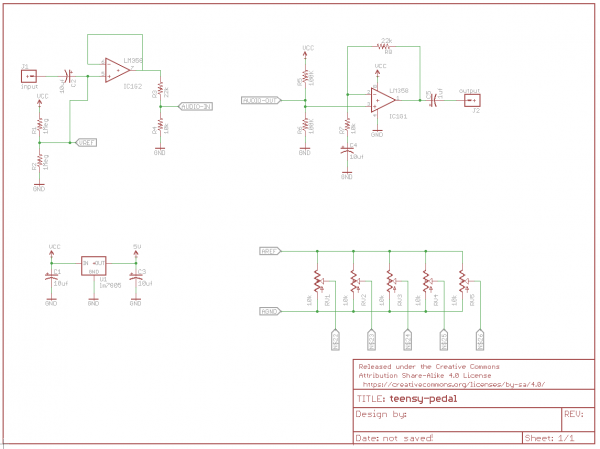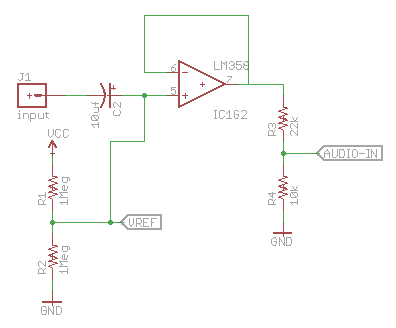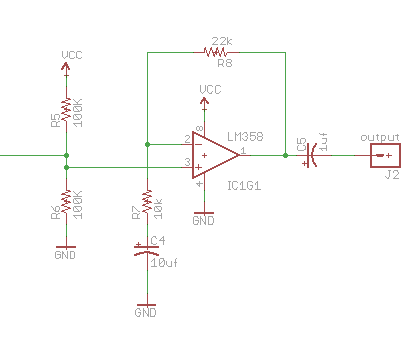Third Update
April 25th, 2018
Update #3
Build
Build Overview
Building this pedal has proved challenging but fun. So far, I’ve built much of the hardware based on the tutorial online. The one change I made was in the microfarads of the capacitors. The lab did not have the 10 microfarads capacitors I needed, so Evan from the Active Learning Labs told me that, since they are just being used for decoupling, that I can use 15 microfarad capacitors instead. The incremental tests throughout the build have worked, so it seems like the change will not effect the build. I plan on finishing by next Wednesday to give myself time to mess with the software components and address any issues I might have with the hardware.
Challenges
One of the biggest challenges I’ve had so far has been with soldering. Our first lab was the first time I had ever soldered, so I’m not particularly good at it. However, for the most part, I’ve done a fine job of making sure everything is in its right place. That being said, during my first session building the hardware, I made a mistake and placed a capacitor in the wrong space. I rushed the process, and soldered the capacitor without checking that I had placed it correctly. It took me about 20 minutes to figure out how to remove the capacitor and replace it, but afterwards, I did an incremental test on the voltage being produced by the circuit, and I was within the range the tutorial suggested. As it appears now, my mistake did not hurt the circuit, and I learned a valuable lesson to not rush myself while building.
Additionally, it has been difficult to actually place the pieces in the right space. This is less of a challenge and more of an annoyance, but I have large fingers, so making sure centimeter long wires are fitting in the small circuit board has been difficult. Overall, though, I’ve enjoyed building the pedal.
A new challenge that I’ve come across involved building the chassis. Sparkfun had their pre-made chassis on backorder, so I decided to buy a metal box with no holes drilled. I am not adept at drilling, so Maddie helped plan where the holes should be drilled and taught me how to do it. However, the holes I made were slightly off, so I wasn’t able to fit the circuit board into the chassis. It took me a few tries, but eventually I just sanded the hole through the box, and it fit. However, the whole I drilled for the power supply was off-center, so I have to use a battery. That’s not a problem, though, because batteries sound better than wall plugs!

Second Update
April 20th, 2018
Update #2
Design
Schematics

Above is a picture of the circuit in the pedal found at https://learn.sparkfun.com/tutorials/proto-pedal-example-programmable-digital-pedal.

All of my understanding of the circuit comes from the tutorial and Jim. The first piece of the circuit is the input. The input signal is coupled to two 1M Ω resistors by a 10 uf capacitor. The capacitor here serves as a short for the audio current but can be effectively removed for the DC current, allowing the biasing resistors to do their job. The resistors here bias the signal to 4.5 VDC. This is to keep the current between 0V and 9V to be fed into the LM358 operational amplifier that is connected. The op-amp is incredibly important to the circuit. It increases the input impedance, but the output is the same as the input signal. This is important for the guitar. The high impedance allows the guitar’s signal to be passed through cleanly without messing with the tone or volume of the signal.
The output of the op-amp is then attenuated by roughly 1/3 in order for the signal to pass through the Teensy. Because this circuit is powered directly by the 9 VDC power supply, the circuit ends up with about 3 V, the input headroom of the Teensy.

This section is the output of the circuit. The operational amplifier here has a gain of 3 to amplify the output back to 9V as the output of the Teensy is 3 V. This is due to the resistor in the feedback loop. As the signal is passed through, it gets multiplied by the inverse of the ratio early, or about 3. Just like in the input, there are two biasing resistors here. Again, the DC voltage becomes 4.5. This becomes a problem, though, if it were to pass straight through the op-amp with a gain of 3. The voltage would be multiplied to 13.5, so to solve this problem, the fourth capacitor is put in place. Just like the first capacitor, this allows the op-amp to act as a follower for the DC current, so 4.5 VDC is passed through to the output while the audio signal is multiplied.

The final piece is the voltage regulator. Because the 9V battery (or wall input) is too high for the Teensy and circuit, this regulator bumps the voltage down to 5V.
This is what I’ve built so far:

Tools and Materials
Currently, I’m just soldering all of the materials that I bought from Sparkfun. Here is the material list:
- 5 electrolytic decoupling capacitors (15uf/25V)
- Teensy 3.2
- Teensy audio board
- DIP sockets solder tail
- LM 358 operational amplifier
- Stranded and solid-core wire
- Break away headers
- Resistors
- 5V voltage regulator
- 5 black knobs
- 5 rotary potentiometers
- Solder
- Soldering iron
- Cutters
- Wire Strippers
- Sparkfun proto pedal
- Chassis
First Update (4/13)
April 10th, 2018
Friday Update #1
Project and Motivation
For my final project, I’m going to be building a reprogrammable guitar effects pedal. I will be closely following a Sparkfun tutorial to build the hardware. The pedal will use a teensy to control the effects, so that is where the project will get creative. There are a number of pre-made effects already online, but I want to build my own custom phaser or flanger. This will be the more time-intensive part of the process, but perhaps the more fulfilling.
This project’s motivation comes from a love of guitar and guitar effects. My own pedal board already has a number of effects (chorus, overdrive, delay), but to complete my sound, I want to add some new effects. Because the pedal is reprogrammable, if I want a different effect for a different recording, I can take the time to make the new effect (albeit not on stage, that would be kind of time-consuming). I really enjoyed playing with Max for our last lab, so I’m excited to mess around with the effects and sounds that it can produce.
Background Research
Building a guitar pedal is pretty difficult to do from scratch. It involves complex circuitry and design, and a in-depth knowledge of sound and effects. Luckily, there is a tutorial online for building the pedal I want to build: https://learn.sparkfun.com/tutorials/proto-pedal-example-programmable-digital-pedal. Like I said, I will follow this tutorial to build the hardware.
Along with the tutorial are a number of pre-made effects: https://github.com/sparkfun/Proto_Pedal/tree/master/projects/teensy-based/sketches. Using these as a starting point, I will build and change them as best I can to create the effects I want.